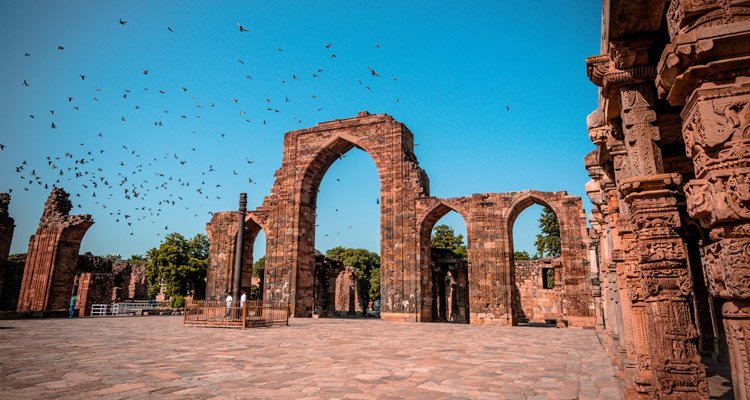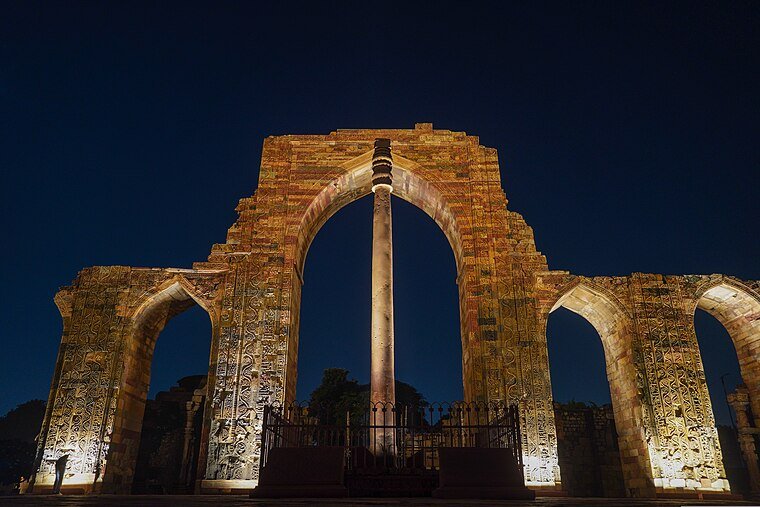Secret of The Iron Pillar : A Monument That Defies Time
Nestled within the Qutub Complex in Delhi stands a pillar that has withstood the ravages of time, climate, and corrosion for over 1,600 years—the Iron Pillar of Delhi. At first glance, it may appear unassuming, just another ancient artifact amidst India’s architectural splendor. But for those who look closer, it reveals a profound tale of scientific ingenuity, philosophical depth, and spiritual devotion. This six-ton column, attributed to the reign of Chandragupta II (circa 4th century CE), remains one of the most enduring examples of ancient Indian metallurgy, fascinating scientists and historians across the world.
The Scientific Marvel of Rust-Resistant Iron
What makes the Iron Pillar extraordinary is its unparalleled resistance to corrosion despite centuries of exposure to Delhi’s varying climate. Modern metallurgists have studied its composition and discovered that the pillar is made of nearly pure wrought iron, with an unusually high phosphorous content and an absence of sulfur and magnesium—factors that contribute to the formation of a protective passive film on the surface. This natural coating has shielded the pillar from decay, allowing it to survive without rusting—a feat that modern technology still finds hard to replicate on such a scale. The craftsmanship reflects a level of metallurgical sophistication far ahead of its time.


Metallurgy as a Sacred Craft
In ancient India, the art of metallurgy was not seen as a mere utilitarian endeavor; it was deeply sacred. The smelting of ores, the shaping of metals, and even the tools used were infused with spiritual significance. Metallurgy was governed by rituals, mantras, and philosophical frameworks that saw metal not just as material, but as tattva—an elemental force with cosmic implications. Each phase of metalwork was aligned with the five elements: earth (source of ore), fire (for smelting), air (to stoke the flames), water (for tempering), and space (the vessel in which the transformation occurs). This deep metaphysical understanding gave rise to creations that were durable not only in form but in essence.
A Pillar Dedicated to the Divine
The Iron Pillar is more than a technological marvel—it is a devotional offering. An inscription in Sanskrit, written in the Brahmi script, reveals that the pillar was erected in honor of Lord Vishnu and celebrates the valor and virtues of a king named Chandra, most likely Chandragupta II of the Gupta dynasty. Originally believed to have stood in a Vishnu temple in Udayagiri (in present-day Madhya Pradesh), the pillar was later moved to its current location in Delhi. Its religious dedication underscores the belief that material mastery must serve a higher purpose—spiritual elevation and societal harmony.
The Spiritual Philosophy Behind the Science
The endurance of the Iron Pillar cannot be explained by metallurgy alone. The ancient Indian worldview did not separate science from spirituality. Knowledge was seen as holistic, where the physical and metaphysical coexisted. The craftsman was not just a worker of hands, but a seeker of truth. The purity of the iron, the precision of construction, and the absence of corrosion are all outcomes of a process that was deeply intentional, ethically guided, and spiritually aligned. This is perhaps the most profound lesson the Iron Pillar offers: sustainability and excellence emerge when action is rooted in purpose and harmony with nature.
Legacy of Indian Metallurgy
India’s legacy in metallurgy extends far beyond the Iron Pillar. From the making of surgical instruments in Sushruta’s time to the creation of zinc distillation furnaces in Zawar (Rajasthan), India led the world in metal science for centuries. Wootz steel, used to create the famed Damascus swords, originated in India and was known for its strength and flexibility. These metallurgical traditions, often passed down through generations of artisans and blacksmiths, were repositories of both scientific and cultural knowledge. They were respected, protected, and celebrated as part of the societal fabric.
A Lesson for the Modern World
In an age driven by rapid industrialization and technological haste, the Iron Pillar reminds us to return to intentional creation. It is a lesson in sustainable innovation, in blending utility with beauty, science with spirituality, and progress with purpose. The pillar stands not only as an artifact of history but as a symbol of India’s enduring wisdom—a beacon of integrated knowledge where craftsmanship is revered, and technology is tempered with consciousness.
Touching the Past, Awakening the Future
To stand beside the Iron Pillar is to touch a civilization that revered both the seen and the unseen. Close your eyes and place your palm on its weathered surface—you might feel the vibrations of chants, the rhythm of ancient forges, and the quiet strength of a culture that never saw knowledge as fragmented. It is not just an iron monument—it is a soul in metal form.
And in its silent strength lies a powerful truth: that greatness lies not in invention alone, but in intention; not merely in progress, but in presence.



